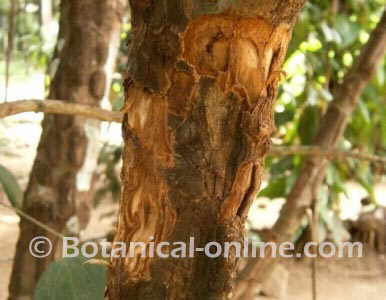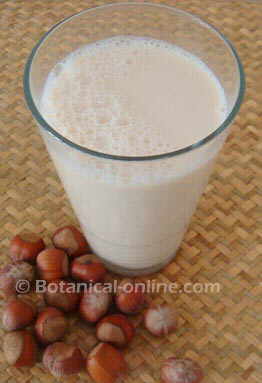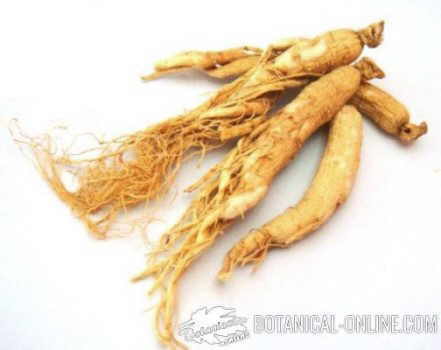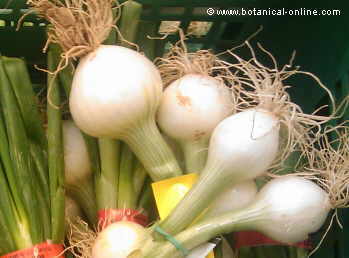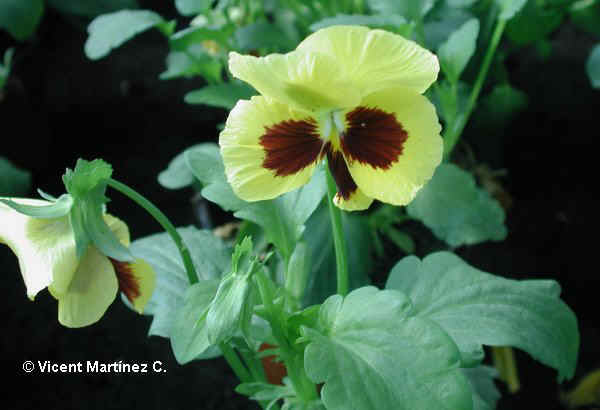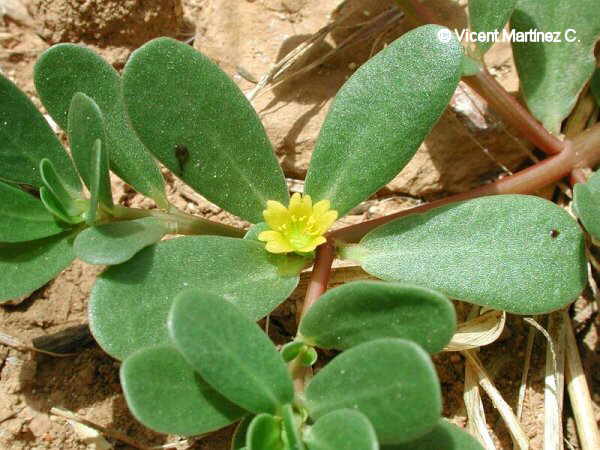Contents
- 1 Classes of vegetables
- 1.1 Classification of vegetables
- 1.2 Types of vegetables according to the plant part that is eaten
- 1.3 Types of vegetables depending on its composition
- 1.4 Types of vegetables according to their origin
- 1.5 Types of vegetables according to its culinary uses
- 1.6 What to take into account when cooking vegetables
Classes of vegetables
Classification of vegetables
There are different criteria to classify the vegetables. These are the main:
Types of vegetables according to the plant part that is eaten
According to what we usually eat from a vegetable, we have the following types:
- Leafy: Those that provide edible tender leaves. Within this group we have: Sorrel, spinach, amaranth, celery, borage, lettuce, cabbage, dandelion, endive, escarole, spinach, lettuce, cress, etc..
- Stem vegetables: From them fresh stems are used as food. The main stem vegetables are the thistles and asparagus.
- Vegetables inflorescences: We consume their tender inflorescences . These vegetables are: broccoli and cauliflower
- Vegetables buds: We eat the tender buds of some vegetables. We have here artichokes and Brussels sprouts.
- Vegetables germs: vegetables are produced by germination of seeds of vegetables or cereals. Among them alfalfa sprouts or bean sprouts are the main ones but there is a large variety of vegetables that are obtained by germination from plants that, in its adult stage, would not be proper vegetables (More information on features, advantages and disadvantages of the “Sprouts“)
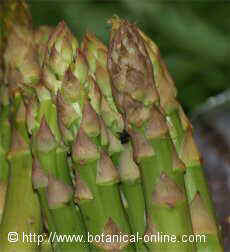 | 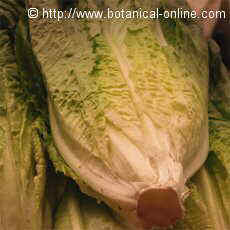 |
| Asparagus Stem vegetable | Lettuce Leafly vegetable |
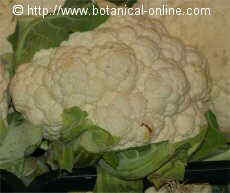 | 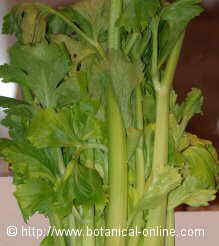 |
| Cauliflower Inflorescence vegetable | Celery Inflorescence vegetable |
Types of vegetables depending on its composition
According to the amount of carbohydrates that vegetables contain, they can be classified into two groups:
- With very few carbohydrates: They are those that do not exceed 6% of its weight. So they do not exceed 30 calories per 100 grams of weight. Within this group, we would include most vegetables.
- With few carbohydrates: These are those containing more than 6% of its weight, exceeding the 30 calories per 100 grams of weight. In this group, as we can see in the table below there are fewer representatives.
| Carbohydrates and calories of some vegetables, per 100 g | ||
| Carbohydrates | Calories | |
| Alfalfa sprouts | 3,78 g | 29 kcal |
| Chard | 3,74 g | 19 kcal |
| Artichokes | 10,5 g | 47 Kcal |
| Amaranth (leaves) | 4, 03g | 23 kcal |
| Celery | 3,65 g | 16 Kcal |
| Watercress (Nasturtium officinale) | 1,29 g | 11 kcal |
| Borage | 3, 06 g | 21 kcal |
| Broccoli | 5,24 g | 28 kcal |
| Corn salad | 3,6 g | 21 kcal |
| Thistles | 4,8 g | 20 Kcal |
| Cabbage | 5,43 g | 25 Kcal |
| Brussels sprouts | 8,96 g | 43 Kcal |
| Cauliflowers | 5,20 g | 25 kcal |
| Dandelion | 9,20 g | 45 kcal |
| Endives | 3,3 g | 17 Kcal |
| Asparagus | 4,54 g | 23 Kcal |
| Spinach | 3, 90 g | 22 Kcal |
| Lettuce | 2,3 g | 13 Kcal |
| Garden cress (Lepidium sativum) | 5, 5 g | 32 kcal |
| Purslane | 3, 43 g | 16 kcal |
Types of vegetables according to their origin
According to the source of the different vegetables, they can be classified into the following sections, bearing in mind that some vegetables come from more than a continent:
- European Origin: These include Swiss chard, watercress, borage, celery, chicory, asparagus, lettuce
- African Origin: Coming from the African continent, we have artichokes, cardoons and asparagus
- Asian origin: We have alfalfa, watercress, cabbage, Chinese cabbage, broccoli, lettuce, asparagus, spinach and purslane
Types of vegetables according to its culinary uses
According to the way of cooking vegetables, they can be classified as follows, bearing in mind that same vegetable can be part of several groups:
- To eat raw: Most vegetables can be eaten raw and it is especially advisable to keep eating them raw if we want they preserve all the vitamins.
Brussels sprouts should not be eaten raw because they are indigestible. The other components of the cabbage family (broccoli, cauliflower, cabbage berzam, Chinese cabbage, kale, etc.) can be eaten raw. If you feel thy present too much flavor or odor, they can be bleached. This is to say, they must be introduced for a couple of minutes in boiling water.
The cultivated asparagus are delicious raw. However, the wild asparagus are very bitter and should be boiled with water or frying oil and discard the cooking liquid before eating.
Some, such as artichokes and cardoons, can be eaten raw, they are too bitter and it’s best cooking.
Spinach can be eaten raw but not abuse because they contain much oxalic acid.
Borage can be eaten raw, once the leaves have good brushing to remove the hairs. If they are not tender enough, it is best to eat them boiled.
- To eat fried: All vegetables can be fried, but especially asparagus are usually fry, spinach and Swiss chard.
- To eat steamed: All vegetables can be steamed, but the most commonly used are often cabbage and broccoli.
- To eat grilled: Many vegetables can be cooked on the grill l, but the most usual ones are the artichokes.
- Food cooked in the pot, stew, etc: All vegetables can be used in this way. You should how to cook them so they do not lose their flavor and nutritional properties. It has been shown that inadequate cooking is responsible for the loss of half of the vitamins. (More information)
What to take into account when cooking vegetables
One should take into account these tips:
- Use, unless they are in poor condition, the outer leaves are greener than those with more vitamins and chlorophyll. If they are black spots faded or present diseases, disposal.
- Wash them just before cooking. Do not use hot water. Washed with tap water at room temperature.
- Put them into the container when the water is boiling. If poured cold water, vegetables turn black due to oxidation.
- If it is green leafy vegetables, do not cover the pan so as not to spoil the vitamins that are very sensitive to high heat and chlorophyll. In the event that these have a white color, as occurred with thistles, the pot will be covered.
- Do not cook for too long, because in doing so break down vitamins and flavor is lost. In addition, overcooked vegetables are very flabby. To maintain the hardness of the vegetables should be added a little salt to the cooking water, except when people cook for which it is not convenient to use sodium as people with fluid retention, kidney problems or hypertension. (See cooking time for vegetables)
- Once cooked, remove them from heat and cool with tap water to remove salt and the heat does not continue spoiling the vitamins
![]() More information about vegetables
More information about vegetables

